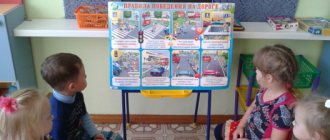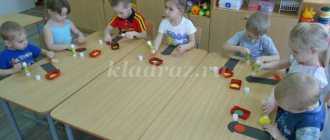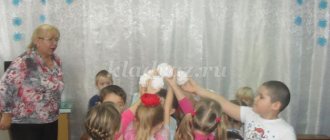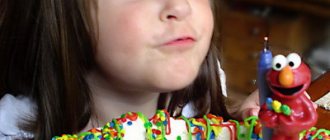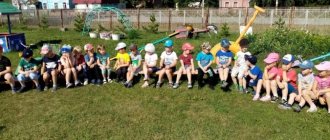Find the warning lights
This game also requires a schematic representation of a traffic light with separate colored circles. But the task is more complicated, intended for the middle group: preschoolers select the signal lights themselves, focusing on the teacher’s leading questions.
Tell the students that there is a problem on the road: cars cannot move because the traffic lights are out of order. Ask the children to help the drivers, return the signals to their place.
During the game, ask the players one by one:
- what color is the signal;
- where it is located - at the top, in the center, at the bottom;
- which means.
If the child finds it difficult to answer, ask the same question to the next player.
Taxi drivers
This is an active game that reinforces ideas about the rules of the road, improves motor activity, and develops the skill of collective action and interaction with friends. For the lesson you need hoops and cardboard circles in 3 colors. Roads and pedestrian crossings must be marked on the playground.
The children are divided into pairs: one is a taxi driver, the other is a passenger. Each pair stands in a hoop, one child holds it with his right hand, the second with his left: this will be a car. Other children become pedestrians and traffic lights, while others receive 3 signal circles.
The game begins: taxi drivers and passengers run along the paths, pedestrians walk along the crossings, the rest show signal lights. Players' actions must be consistent with traffic signals. If necessary, the teacher gives hints and corrects the students’ movements.
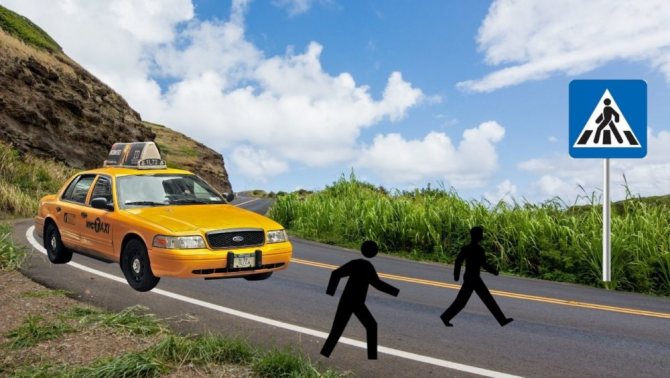
Traffic light
The purpose of the didactic game “Traffic Light” is to develop an understanding of what a traffic light is, why it is needed on the road, and what the light signals mean.
The lesson is intended for the younger group of kindergarten. To carry it out, prepare a schematic representation of a traffic light with unpainted signal lights, and separately – cardboard circles of 3 corresponding colors.
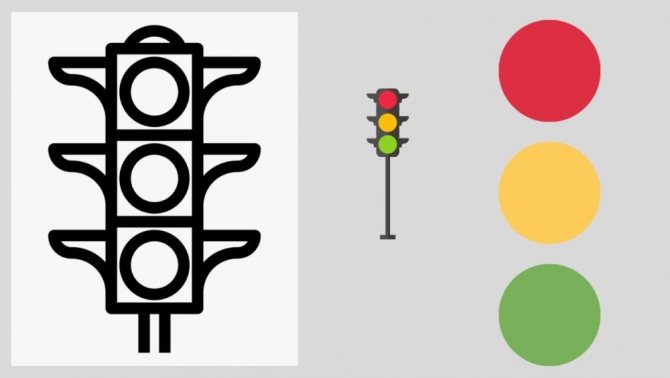
Give the children circles and tell them what function the device performs on the road. Name the color one by one, and the children must guess and explain what the indicated color could mean: red - wait, yellow - wait, green - you can go. At the end of the lesson, students, with the help of the teacher, distribute circles according to signal lights.
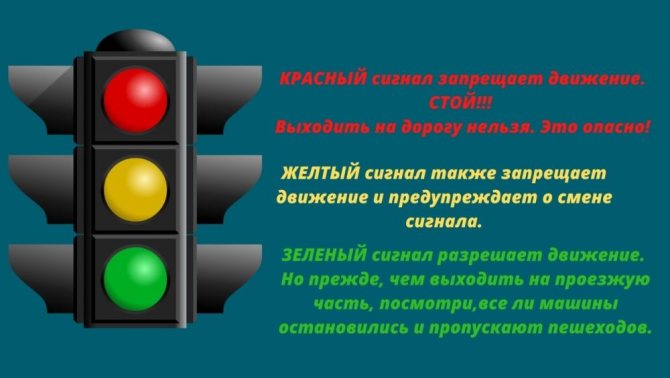
Build a traffic light
The didactic game “Assemble a traffic light” reinforces the idea of the purpose of a road device, develops attentiveness and thinking abilities. For the lesson, prepare images of traffic lights - one per player, and circles made of cardboard in 3 colors. Randomly cut each circle into 4 parts.
Tell the students that the traffic lights are broken and need to be fixed. Children fold circles according to colors and order of arrangement. At the end of the work, the students tell what each traffic light means.
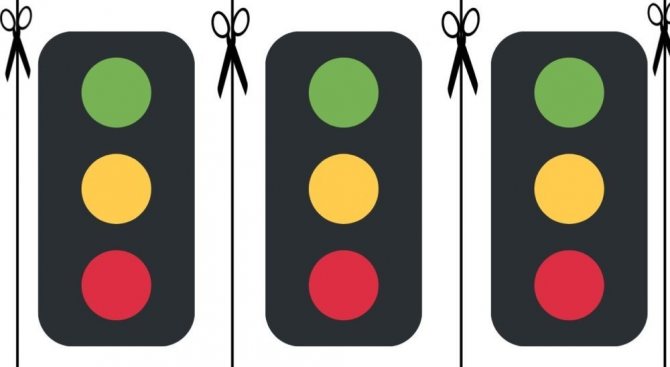
Red, yellow, green: GCD for traffic rules in the younger group
Abstract : A conversation about traffic rules, taking care of your health, expanding children's knowledge about types of passenger transport, their onomatopoeia and consolidating children's knowledge of primary colors.
Key words : “bi-bi”, “chukh-chukh”, “pedestrian crossing” (“zebra”), “street” and intensify the use of words: “train”, “car”, “plane”, “traffic light”.
Program content:
- To consolidate children's knowledge of primary colors (red, yellow, green).
- Learn to take care of your health, pronounce onomatopoeia “r-r-r”, “u-u-u” loudly and quietly, and promote the development of the vocal apparatus.
- Continue to teach how to pronounce sound combinations: “bi-bi”, “chukh-chukh” and expand children’s knowledge about types of passenger transport and their onomatopoeia.
- Give children an idea of where and how to cross the street, introduce them to special signs - pedestrian crossing signs, and introduce the word “crossing” into the children’s active vocabulary.
- Develop children's coherent speech, thinking, memory, attention.
- Develop the ability to be polite and attentive towards each other.
Methods and techniques : didactic game, observation, conversation, looking at photos, taking a problem situation, a surprise moment, showing a method of action during breathing exercises, showing animal toys, game methods, breathing exercises, using TSO.
Vocabulary work: “bi-bi”, “chukh-chukh”, “pedestrian crossing” (“zebra”), “street” and intensify the use of words: “train”, “car”, “plane”, “traffic light”.
Preliminary work: Examination of illustrations from the series “Road Rules” and animals. Talking with children about animals and traffic rules. Practicing the concepts of words in an active dictionary. Reading works of fiction, studying the song “A grasshopper sat in the grass.” Organization of games: outdoor games “Planes”, “Traffic lights and pedestrians”, didactic game “Collect a flower”.
Equipment and visual material : TSO (tape recorder, recording of the melody for the song “a grasshopper sat in the grass”), colorful houses, Traffic lights, “zebra” (pedestrian crossing), toys of Traffic Light, Little Red Riding Hood, Gena the crocodile, Chicken, other animals or beasts, d/game “Collect a flower”: flower stencil and red petals, green, red, yellow circles, postcards or “Traffic Light” crafts, multi-colored balloons.
Literature:
- Marshak S. Traffic light.
- Mikhalkov S. My street.
- Knyazeva O.L., Sterkina R.B. Safety.
- Saulina T.F. Three traffic lights.
GCD move
Psycho-gymnastics “Good morning”
Educator: Guys, I am very glad to see you cheerful and healthy. Let's all hold hands and say loudly to our guests: “Good morning!”, And now let's turn to face each other and say in a whisper: “Good morning!” Children, look how beautiful my balloons are. What color are they?
Children : red, yellow, green.
Educator : Oh, guys, who is sitting and crying?
Educator: A traffic light came to us and was crying. But why?
Svetoforik: Trouble happened to my dad, Svetofor Svetoforovich. In the fairy-tale city where he is standing on the street, it rained heavily, and the paint was washed off from dad’s eyes. Now the lights in his eyes don’t shine, accidents happen in the city every day, so Svetofor Svetoforovich cannot help people: neither drivers nor pedestrians. Here, look. (showing a photo of a traffic light without lights).
Help me find paints for my dad.
Educator : Shall we help, guys? Do you think we can help? (Problem situation) To help you, we need to go to a fairy-tale city. What type of transport can we use?
Children : by plane, by car, by train.
Educator : How does the car drive? (bi – bi). What about the train? (chug - chug).
What is the fastest way to get to the fairy-tale city?
Children : By plane.
Educator : Let's all fly on an airplane. And we’ll take the traffic light with us. How does the plane hum when it picks up speed quietly or loudly?
Children: (Loudly) ooh – ooh – ooh!
Educator: And when does he slow down and fly to land?
Children: (Quiet) uh-uh!
Educator: Get ready. They started the motors r - r - r. The wings of the planes spread. Let's fly!
The outdoor game “Airplanes” is played.
Educator: We flew with you to a fabulous city. Look how many flowers there are! Let's smell their scent.
Breathing exercises “The Aroma of Flowers”.
Educator : We take a calm breath through the nose, hold our breath and slowly exhale “Ah - ah!”
Look, guys, we ended up right on a multi-colored street. What color are the houses on this street?
Children : red, yellow, green.
Traffic light : My friends live on this street: yellow Chicken, Little Red Riding Hood and green Crocodile Gena.
Educator : Now let's go to them. They will be able to help us. What do you guys think, in which of these houses does the yellow chicken live?
Children : In yellow.
Educator : Varya, come to the yellow house. Children, did Varya find the yellow house correctly?
Children : Yes, this is a yellow house.
Educator : Then let's knock and see if the Chicken really lives in it. (Knocking)
Chicken (comes out) . Pi-pi-pi. Good afternoon, kids, I’m glad to welcome you.
Educator : Good afternoon, Yellow Chicken. Can you help us: can you give us some yellow paint for Traffic Light Svetoforovich?
Chicken : Pee - pee - pee. I'll be happy to help, but you have to tell me what the yellow color is.
Children : (called) Chicken, sunshine, banana, lemon, dandelion, melon, pear, leaves in autumn...
Chicken : pee - pee - pee. Well done kids, here's some yellow paint for you.
Gives the children a yellow circle.
Educator : Thank you. Chick. Now let's go to Little Red Riding Hood. What house do you think she lives in?
Children : In red.
Educator : Dima, come to the red house. What do you think, children, did Dima find the house correctly? Let's knock and see who comes out. (Knocking)
Little Red Riding Hood : Good afternoon. What brings you to my house?
Teacher, children : Good afternoon, Little Red Riding Hood. We are looking for paints for Svetoforovich Svetoforovich. Can you give us some red paint?
Little Red Riding Hood : Of course, I will. But first, help me. Plant red flowers near my house.
Didactic game “Collect a flower” (Children look for red petals and put them in a flower stencil.)
Little Red Riding Hood : Well done, children! Here is the red paint, as you asked for the Svetoforovich Svetoforovich. (Gives the children red circles)
Educator : Thank you, Little Red Riding Hood. It's time for us to go to the crocodile Gena. I wonder, children, which of these houses does the crocodile Gena live in?
Children : In green.
Educator : So, where is the green house? What do you think, Lera? Let's knock on him.
Crocodile Gena : (comes out). Good afternoon, kids!
Teacher, children : Good afternoon, Gena the crocodile. Can you give us some green paint for Traffic Light Svetoforovich?
Crocodile Gena : Of course, I’ll give it to you. I really love this paint and am even friends with those little animals that are green. Please find among these animals (animals) those who can be called my friends.
Children : This is a green frog, a dragon, a crocodile, a dinosaur.
Crocodile Gena : What green song do you know?
Children: “There was a grasshopper sitting in the grass.”
Educator: We’ll sing it for you now, right, children?
A melody sounds. (Children sing 1 verse)
Crocodile Gena : Well done, children! Here's some green paint for you. ( Gives the children green circles).
Educator : Thank you, crocodile Gena. And here is Svetoforovich Svetoforovich standing. Now we will color his eyes. (The teacher glues circles to the Traffic Light.) Children, look at this path. Who knows what it's called? This is a “zebra crossing” and it is called “Pedestrian Crossing”. What is the name of? (children repeat together and one at a time). Only along it, at the “pedestrian crossing,” can you cross the street and only when the traffic light is green. And at a red light, what should we do? (Stand). Right. What does the yellow traffic light mean? (You need to get ready to cross the street). Well done, children. And one more thing, guys. While you are still little, you should cross the road only with adults, with your mothers and fathers. Now Traffic Light can play with us.
Game “Traffic Lights and Pedestrians” Children, at the teacher’s signal - call the light at the traffic light - perform the appropriate actions.
Educator : Children, let's thank the friends of the Traffic Light and give them our colorful balls. Each person has a ball of his own color (they return to the houses and give balls). Thanks for the help. Goodbye friends.
Traffic light: Here you go, guys, and don’t forget to follow the traffic rules. Now hold hands, let's make a circle and say: “We are very good.” First in a whisper, and then loudly.
Pick up the signal light
The game is competitive, 3 preschoolers play. Prepare for the lesson images of traffic lights, in which two lights are colored, and instead of the third there is an empty circle. You also need cardboard circles in 3 colors.
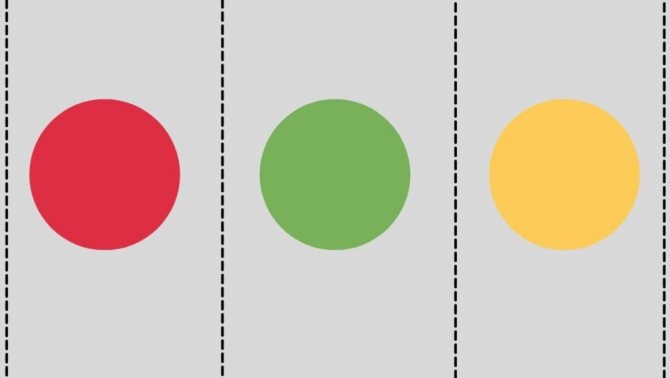
Place the images in front of the players. Ask them to remember what color the unpainted signal circle should be. Children remember, choose a cut out circle, and apply it to an unpainted traffic light. The player who makes the most correct moves and completes the task faster than his comrades wins.
The game for the preparatory group can be complicated by turning the cut out circles upside down. Players take turns taking circles, turning them over, calling a color, and seeing if the color suits their traffic light. If yes, they put it on the corresponding signal light; if not, they put it aside and pass the move to a comrade.
Traffic light
To conduct the game “Traffic Light” in the older group, make preparations: divide the landscape sheets in half, on one half depict a traffic light with incorrectly located lights, on the other - a device with empty circles instead of signals. Separately cut out circles of 3 colors.
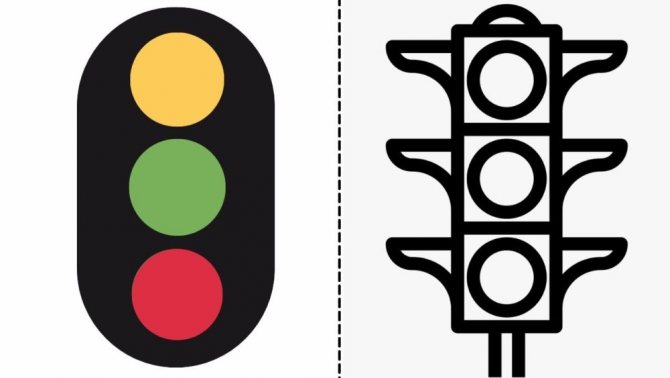
The players' task is to identify the incorrect placement of lights. On the neighboring device you need to display the light signals correctly, arranging the circles accordingly.
STORY-ROLE-PLAYING GAME “TRAFFIC LIGHTS”
Transcript
1 STORY-ROLE-PLAYING GAME “TRAFFIC LIGHTS” PROGRAM OBJECTIVES: To clarify and consolidate children’s knowledge about traffic rules. Exercise the ability to apply knowledge in practice. Develop friendly relationships, the ability to obey the rules of the game. METHODOLOGICAL TECHNIQUES: Offer children attributes for the game, help distribute roles, use active participation in the game. RESULT: Mark the children who correctly followed the rules of the game and behaved correctly towards their comrades. Preliminary work 1. Reading works 2. Excursion 3. Memorizing songs, poems 4. Looking at pictures 5. Making attributes for the game. PROCEDURE After sleep, the teacher brings in the attributes for the game “Traffic Light” and asks: “What can you play with these things?” Children's answers: “You can play the game “Traffic Light.” I suggest using a counting rhyme to select the participants in the game, asking what role they will play, if desired. The remaining children depict a transition, pedestrians who are rushing to work, to the library, store, etc. During the game I help with advice and deeds. I monitor the children’s relationships, how they have learned the traffic rules, and whether they violate them.
2 PLAN FOR CONDUCTING THE ROLE-PLAYING GAME “ROAD TRAFFIC” (Preparatory group) 1. City tour by bus. Goal: to establish the rules of behavior for pedestrians and vehicle traffic on the street. 2. Watching the filmstrips “Three Good Genies”, “I Don’t Want to Go to a Fairy Tale”, “Petya with Grisha” and “Trezor”. Goal: to consolidate the rules of the road, the rules for avoiding stopped vehicles. 3. Examination of the album, posters Purpose: to reinforce the rules of the road and explain behavior on the street. 4. Learning children's songs "Transition" music. Zapolskaya, “Song about the rules.” 5. Examination of illustrations: “So and not so.” 6. Conversation “Our city”, “Children’s behavior on the street”. The goal is to reinforce the rules of the road. Questions: What is a street? Why should pedestrians walk on the right side of the sidewalk? Why can't you play on the pavement? 7. Conversation: “Where does the passenger wait for his transport?” Goal: to consolidate children's knowledge that pedestrians walk on the sidewalk and cars drive along the roadway? Questions: Are citizens doing the right thing when crossing the streets? What would happen if no one followed traffic rules? Who controls the traffic on the pavement, at the intersection? 8. Memorizing the poem “Guard” by Y. Pishumov. Goal: to consolidate the knowledge that the movement of cars is controlled not only by the guard. Questions: Where is the guard stationed? Why do all drivers obey the guard's signal? When all the cars are parked on the pavement, what do pedestrians do? (Go) 9. Reading the work “How a car learned to walk.” 10. Game “We are going, we are going.” Goal: get to the final destination faster, following the traffic rules.
3 Progress of the game: The track shows city streets with arrows indicating where to go. Children throw the dice and go where indicated on the dice along the city street, following the rules for driving on the street. Those who do not violate traffic rules are given tokens. The winner is the one who arrives first to the final destination while retaining the most tokens. 11. Game "Street". Goal: to learn to determine by a traffic light signal in which direction the movement of vehicles and people is allowed. Reinforce knowledge of traffic rules with children. Attributes: Track with several streets, road signs (parking, no entry, beware of children, ambulance parking, right, left turns, 3 active traffic lights on the line). Roles: traffic controller, teacher, 1 child mechanic. 1 child motorcyclist, 1 child salesperson, 1 child teacher. Rules of the game: There is a store at the end of the main street, and a kindergarten on the other street. Following traffic rules, children go to kindergarten to the store, take a taxi home, and carry bread in bread trucks. The “doll” children are picked up from kindergarten only after work. 12. Game "Road Traffic". Goal: continue to teach children to navigate the direction of traffic and pedestrians based on traffic lights. Reinforce knowledge of traffic rules with children. Roles: child traffic controller, 1 child bread truck, one child milk truck, 1 child taxi driver, 1 child ambulance. In the store there is a salesperson, a cashier, in the hospital there is a doctor, a nurse, in a kindergarten there are 2 teachers, a nanny, a doctor in an ambulance. Rules of the game: children go to the store, kindergarten, hospital, cinema, observing traffic rules. At the end of the working day, they park their cars in the “parking lot” and go like pedestrians to the cinema, shops, or kindergartens. If they violate traffic rules, they are strictly monitored by a policeman. Pedestrians are fined and drivers are given a ticket.
4
5 Goal: to consolidate the rules of behavior for children on the road. Develop intelligence, ingenuity, and independence. Material: o warning, prohibition, directional road signs; o filming capes depicting the uniform of a traffic controller, various cars, a bicycle, a motorcycle; o pieces of equipment: a “traffic light” cape with removable signal lights, a traffic controller’s baton. Game 1 “Traffic light at the intersection” The teacher talks about the role of a traffic light on the street, which means red, yellow and green. The game accepts an unlimited number of children. Leading traffic light. Children are required to know the rules for crossing the road and driving vehicles. To play the game you need to build an intersection out of rectangles, use arrows to indicate “crossings”, “stop lines”, and safety islands with chalk. The leading traffic light stands in the center of the intersection, the rest are divided into two groups: “pedestrians” and “transport”. The traffic light alternates between moving red, yellow and green signal lights. The intersection comes to life: pedestrians walk, vehicles move. Those who violated the rules of the game, i.e. movements are eliminated from the game. Game 2 “Signs on the roads” The game should be preceded by conversations in which the teacher explains the meaning and meaning of road signs, the duties of a traffic controller, etc. Having drawn streets, intersections, squares from rectangles and placing appropriate signs on them, the teacher organizes an exciting game in which there are the roles of drivers of various cars, a cyclist, a motorcyclist, pedestrians, a traffic controller, and a traffic light. The teacher can be in the role of the chief inspector of the traffic police, giving the correct explanations in this or that “conflict” case. In the game, the guys must change roles in order to take turns getting acquainted with the basic rules for drivers, the responsibilities of a pedestrian, and a traffic controller.
6 GAME “KNOWING PEDESTRIAN” The game is played in an area where there is an intersection or a pedestrian path, and there is a traffic light. (Children in costumes) Children go in subgroups. Approaching the street, they ask: “Street, street, can we cross the pavement?” The street says: “It’s okay if you answer one question.” Asks a question about traffic rules. Questions are asked until the walking children can answer. Whose link answers correctly and quickly will arrive at the designated place earlier and receive a flag.
7 OUTDOOR GAMES FOR STUDYING ROAD RULES Outdoor games occupy a prominent place in the leisure time of preschoolers. They help children give knowledge of traffic rules in an entertaining way, instill in them the teachings and skills of correct behavior on the street, arouse interest in the movement of vehicles and pedestrians, in the transport itself, respect for the work of vehicle drivers, and the work of traffic police officers. During the game, children consolidate and improve useful skills, and develop the ability to act in continuously changing conditions. The game teaches the child to interact with the team, to subordinate his interests to the interests of others. Outdoor games can be carried out in the form of attractions with elements of competition, etc.
8 WHOSE LINE IS THE FIRST TWO, THREE TEAMS. There are tables in front of them, on which they place a sheet of blank paper and colored pencils (red, yellow, green for each). On command, one from each team runs up to the table and draws a traffic light in order. The first draws a red circle, the second yellow, the third green. The link with no errors wins.
9 TRAFFIC RULES YOU NEED TO REMEMBER THIS! 1. The red light came on. There is no way for the pedestrian! 2. Light green path is clear along the pedestrian path. 3. Where you can cross without risk. 4. On the street, not in the room, remember that, guys! 5. Guys! Place to play Not pavements, but courtyards. 6. I decided to take a ride. A boy without a ticket can pay dearly for this! 7. We must always keep to the left on the highway! 8. If the light turns yellow, Stop! Wait for the shift signals, go to the green light! 9. Guys! Be disciplined on the street. Take care of your life. Playing on the pavement is dangerous!
10 CHILDREN! BE DISCIPLINED 1. Walk only on the sidewalk. 2. Cross the street only in places where there are lines or a crossing sign, and where there are none at intersections along the sidewalk line. 3. When crossing the street, look to the left, and when you reach the middle, look to the right. 4. On streets and roads where traffic is regulated, cross the roadways when the traffic light is green or the traffic controller gives permission. 5. Do not cross the road when there is nearby traffic. 6. Do not ride on the running boards or ledges of the tram. 7. Walk around a stopped tram only from the front, only then can you see the oncoming tram. 8. Walk around a bus or trolleybus standing at a stop only at the permitted crossing point, while being careful. 9. Do not arrange games, do not ski, skate or sled on the roadway. 10. Riding bicycles on streets and roads is permitted for children at least 14 years of age.
11 GUESSING GAME! The players stand in a row. On the floor in front of everyone are several signs with road signs (upside down). The presenter has the same set of signs. He opens any sign from his set. Participants in the game must quickly find the same one in their kit. The winner is the one who quickly finds the sign, and then correctly names it and explains the meaning.
12 CONVERSATION ABOUT SIGNS Program content: Reinforce the idea of prohibition signs. Getting to know the new “prescriptive” signs that are most often found in the city. Teach children the rules of behavior on the street. Enrichment of the dictionary: “Prescriptive” signs. Material: Signs. PROGRESS OF THE LESSON Educator: Children, who will remember what signs we have already met? Answer: “Prohibiting.” Educator: “Who will name and show the “prohibitory” signs? The answer is 2-3 children. Educator: Okay, well done! You have already memorized the prohibition signs. And today I will introduce you to other signs. They are called "prescriptive". They say that cars can pass here, but here they should go around the obstacle. Look, this is what they are like. All these signs are in blue circles. This sign means: “Pedestrian path.” Who can tell me what “Pedestrian Path” means? Answer: “This means you can cross the street.” Educator: Who can guess what this sign means, a bicycle in a blue circle? Answer: Bike path. Educator: Yes, only bicycles are allowed. Answer: Ask 2-3 children what this sign means. Educator: And this sign allows only passenger cars. Blue circle with a car. These signs allow movement only by those drawn in the circle. Now we will repeat to you what these signs allow? Children's answers: Educator: What are these signs called in one word? Answer: Prescriptive. Educator: what do they mean? Answer: Allowed. Educator: What does this sign allow or prescribe? And this one? Children's answers: Educator: Okay, now listen to the poem “Road Signs”:
13 That the cars were in no hurry, The pedestrian walked calmly, We decided to help them, We are on duty all year round. The smallest Road Sign, It stands for a reason. Be careful, respect every sign! Educator: The lesson is over, you can come up and look at these signs again.
14 EXAMINATION OF PICTURES “STREET” Purpose: To consolidate ideas about traffic rules, consolidate street behavior skills, teach children to compose descriptive stories, and highlight the essential. Cultivate observation skills. Activate vocabulary: Roadway, sidewalk, crossing, road signs, buildings. PROGRESS At what time of day does what is shown in the picture happen? Where do pedestrians go? Where are they going? How do they cross the road? How does the transport move? What signs are visible in the pictures? What do they mean? Listen to the poem and find a picture to go with it: Pedestrians are rushing to spend the night, You won’t see the guys anywhere. And only train stations, factories, clocks, traffic lights, cars do not sleep. (S. Marshak) When the children find the picture, ask: “What do the children do at night? Do all adults sleep at night? Who works? (Police officers, traffic controllers) (The pictures are intended for viewing with children individually and in subgroups in the morning, in the 2nd half of the day).
